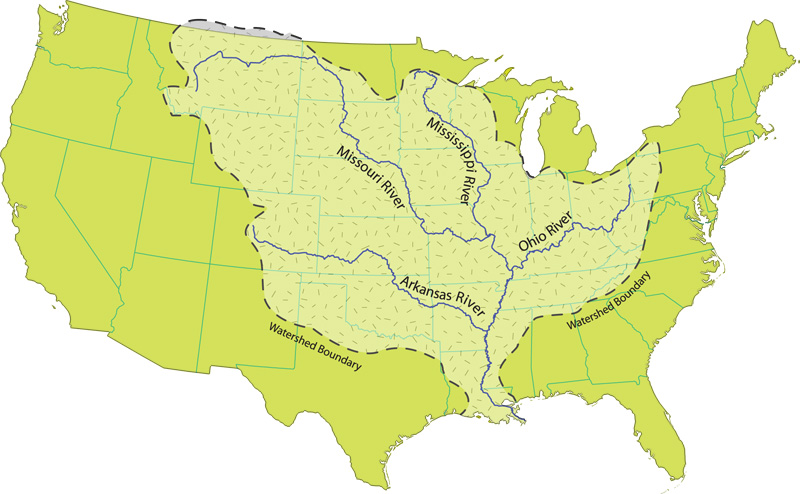|
Credit: National Park Service |
Credit: Wikipedia |
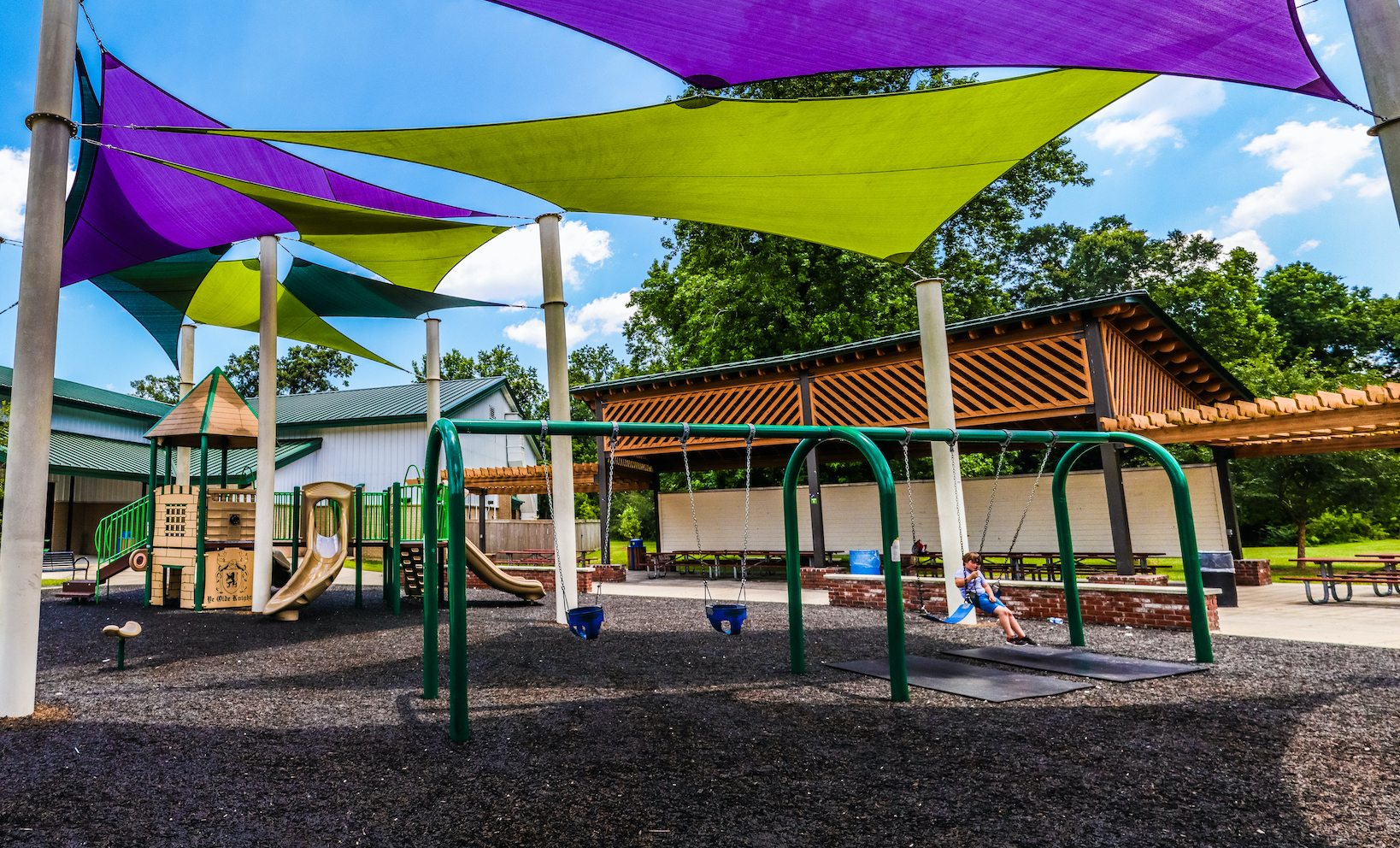
Watersheds in East Baton Rouge Parish
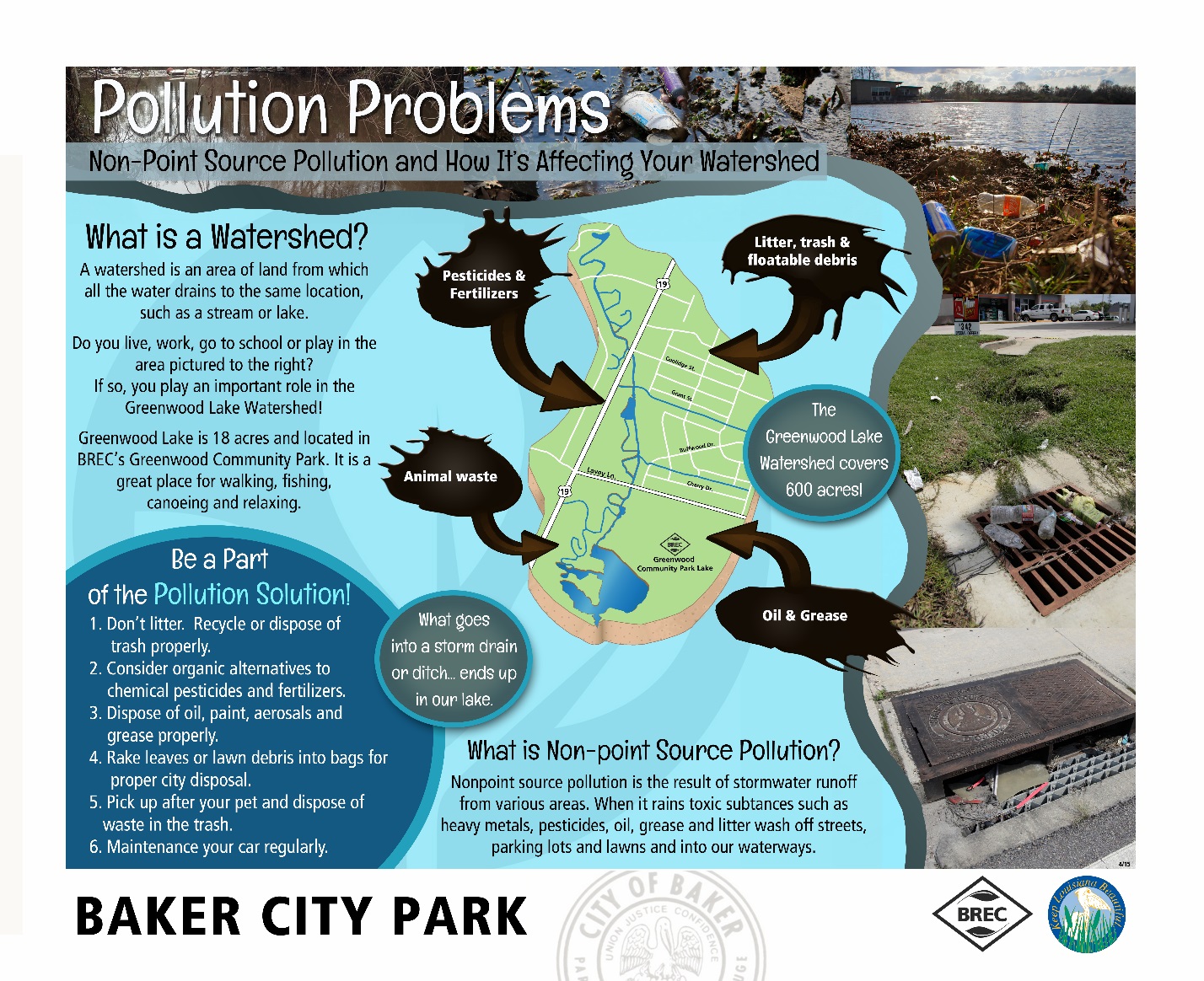
BREC maintains over 180 parks throughout East Baton Rouge Parish. Many of those parks contain waterbodies which serves as large collection points for stormwater run-off and whatever else the rain washes into them. These areas like Greenwood and City Park Lakes also serve as great recreation outlets for activities such as fishing, kayaking and bird watching. These parks play a crucial role in the surrounding watershed but face serious problems such as non-point source pollution and floating litter.
Check out the information below to learn more about watersheds and how BREC parks factor into this sensitive system.
What is a Watershed?
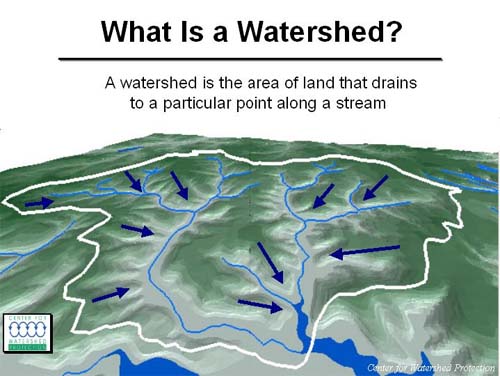
A watershed is an area of land that drains towards a common water body such as a larger river, lake, bay or ocean.
Watersheds exist at many different scales. For example, the Misssissippi River Watershed is the fourth largest in the world and spans 31 states and 2 Canadian provinces. The water quality in the Mississippi River and the Gulf of Mexico near Louisiana is heavily influenced by the activities of the many farms, cities, industries and natural areas contained within this watershed.
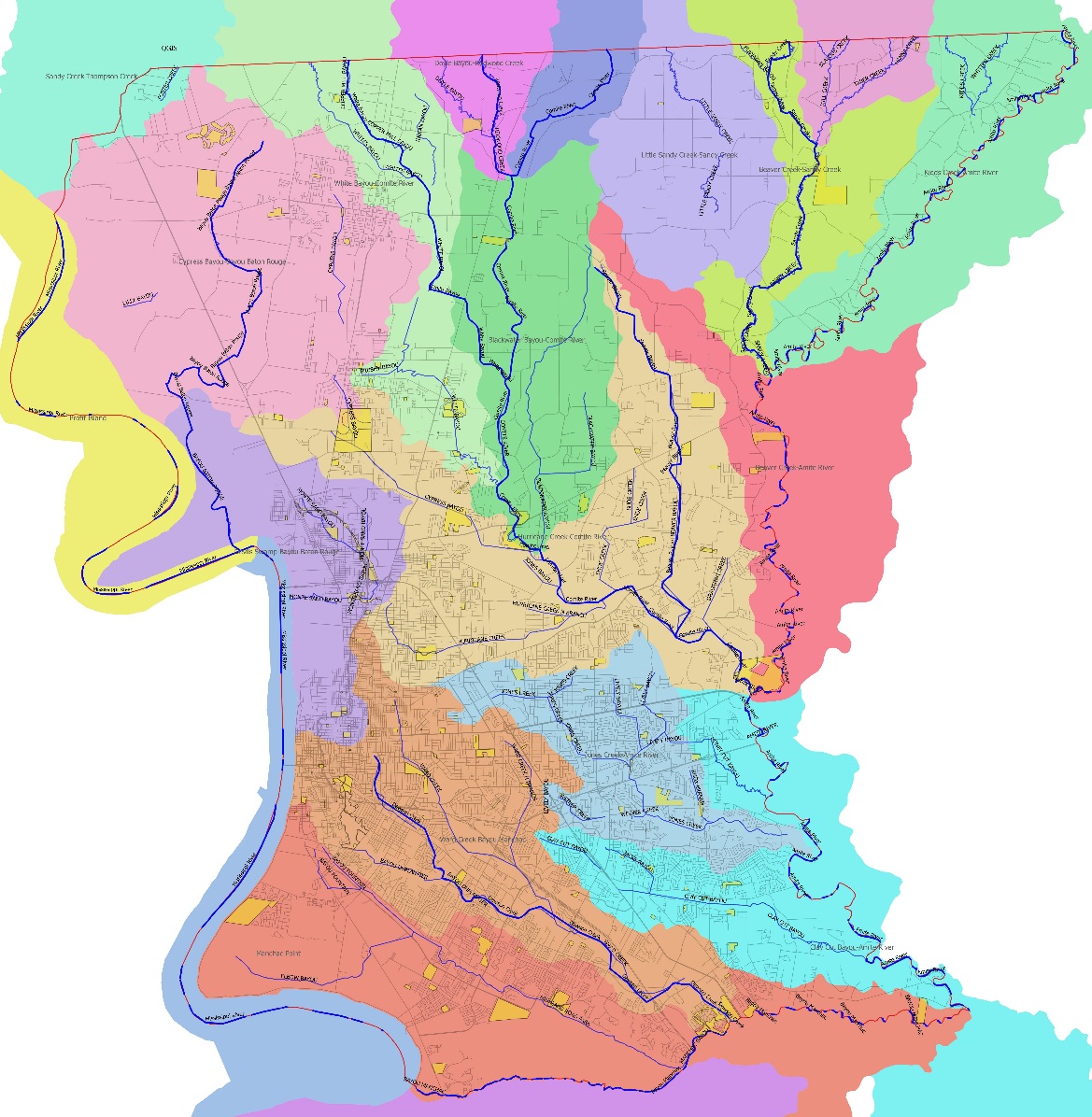
Much of East Baton Rouge Parish is bounded by the Comite River Watershed which drains into the Lake Pontchartrain Basin and ultimately the Gulf of Mexico. A closer look at East Baton Rouge reveals many smaller watersheds created by streams and small rivers.
Many of these watersheds have been heavily changed by the activities of people, reducing wildlife habitat, making waters unsafe for swimming and fishing and causing extreme flood events. Most water issues are the direct or indirect result of urban development and the loss of natural vegetation on the landscape. Essentially as we clear the land of trees, shrubs and grasses to develop and build houses, shopping malls, restaurants, parking lots, etc. we remove the lands ability to hold water and ultimately clean the water. This results in more drastic flood events, poorer water quality and more soil loss to erosion. We often see these effects in BREC parks but you can help to make a difference.
Check out the Watershed issues that East Baton Rouge Parish faces below and see how you can help!
Watershed Issues
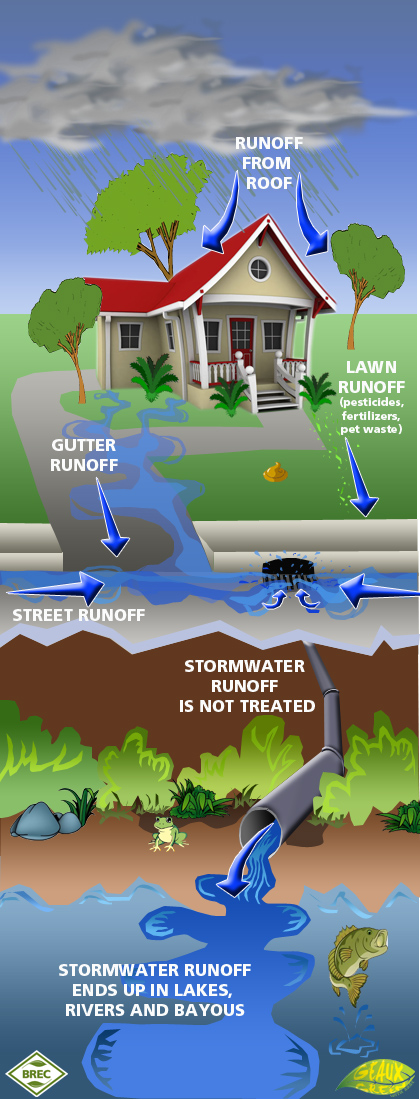
PROBLEM: Non-Point Source Pollution
Non-point source pollution is pollution that is carried from many different sources into a common waterbody due to rainfall. Pet waste, oil leaks on cars, soil eroding from construction, chemical fertilizers, soaps and pesticides and much more all wash into ditches, creeks and canals that ultimately feed into the Comite River and Lake Pontchartrain.
SOLUTION:
- Don’t pour anything but plain water onto streets or into storm drains. This flows straight to the nearest stream and ultimately into the Comite or Mississippi River.
- Dispose of chemicals and batteries in designated locations. Many household materials such as oil, medicine, cleaners and paint, are considered hazardous and should not be put directly into the environment or down the sink or toilette. Bring to a designated disposal facility or go to one of the Hazardous Disposal Collection Days. Visit the Baton Rouge Recycling Office Website for information. Avoid storing chemical and batteries outside where they are exposed to weather and prone to leaching.
- Use organic gardening techniques that reduce the need for harsh pesticide and herbicide. Organic gardening is better for water and fosters biodiversity, too!
- Pick up dog waste and dispose in proper container. If you like to compost, you can actually compost dog waste.
- Use biodegradable soaps when washing cars, siding, outdoor furniture, etc.
- When cleaning up the yard make sure you do not rake or sweep leaf litter or lawn clippings into the street or storm drain. Although this material is biodegradable, it washes into the drains clogging the system resulting in flooding. Additionally, these materials introduce a large amount of organic material unnaturally i to waterways causing imbalances. The best way to remove is to start a compost pile or bag this waste and leave on the street for City pick-up.
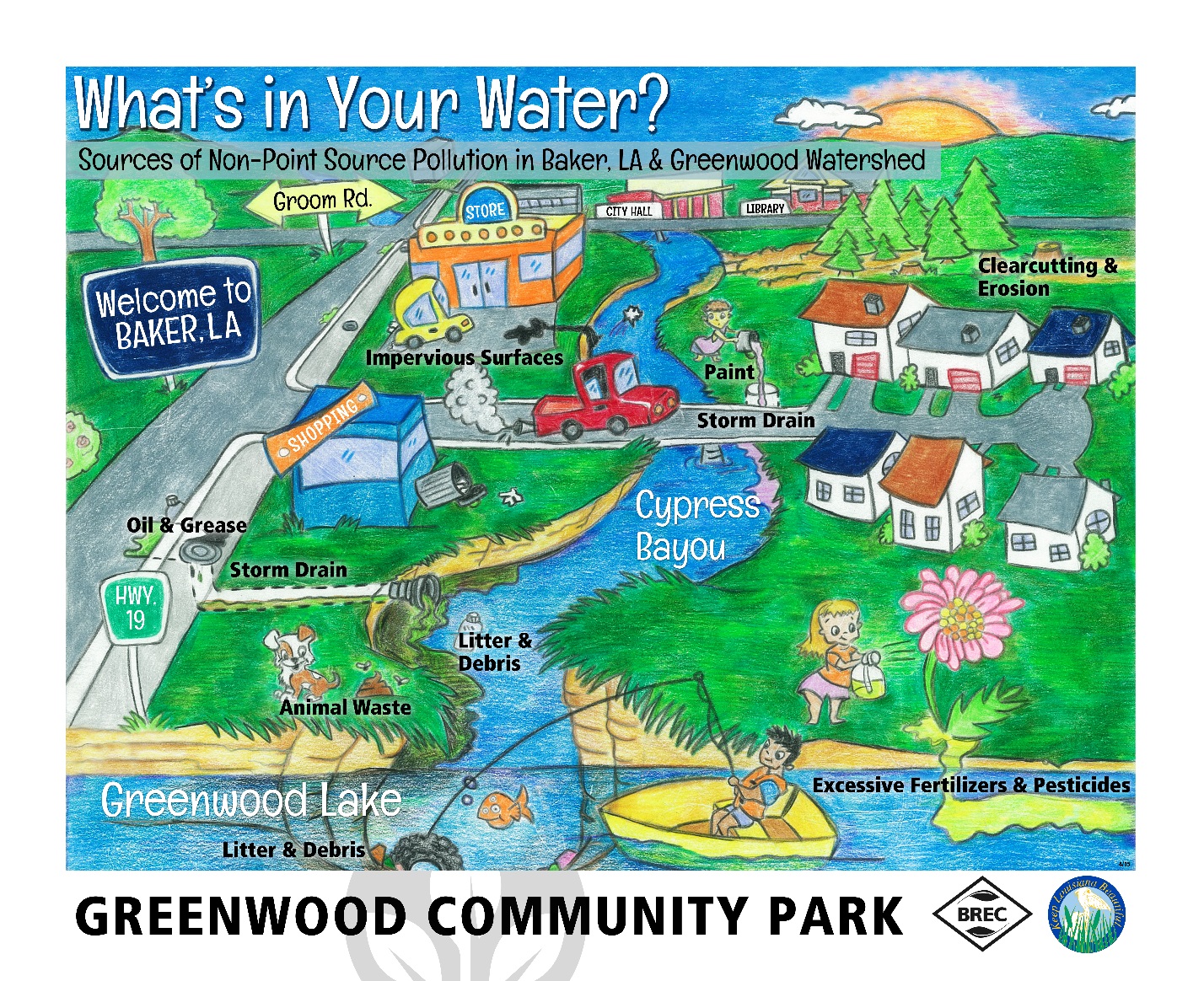
Greenwood Lake at Greenwood Community Park is heavily affected by non-point source pollution that is flushed into the lake during rain events from the surrounding development just north in Baker. To keep the lake healthy requires effort from everyone living in the Greenwood Lake watershed.
 |
 |
PROBLEM: Floating debris and trash
Though some trash is intentionally thrown on the ground, much trash enters the environment unintentionally through improper disposal, storage or simple neglect. Any light piece of trash—wrappers, styrofoam cups, chip bags, water bottles, etc.--can quickly be lost to the wind or water if left on a picnic table, on the floorboard of a car, in the back of a pickup truck or on the ground.
SOLUTION:
- Secure loose items in your car before rolling windows down and clean your car regularly to keep loose trash from escaping. Do not leave any loose items in the back of your truck where it might blow away.
- If a trash can is overflowing, do not simply stack trash loosely on top where it is destined to blow away. At home, bag overflow trash and secure with a knot or twist tie. Keep cans secure so that they are not blown over or rummaged through by animals. In a public outdoor location, alert the nearest attendant of any overflowing trashcans and look for a less full garbage can nearby.
- Always prepare for outdoor excursions by bring a designated bag to keep trash contained, in the event that a garbage can is not available. Secure trash away from wind and water in a backpack, tackle box, or other field container. Scout your area for trash before leaving and keep a close eye on children, which are prone to accidental littering.
- Go the extra mile by sharing your watershed knowledge with neighbors and friends.

Credit: Wild for Prospect Park
PROBLEM: Fishing line and gear
Fishing line, hooks, bobbers, coolers and other fishing gear is commonly found in many of our waterways and result in unsightly public spaces and dangerous conditions for people and wildlife. Fishing line that is left unattended can entangle wildlife like birds and turtles and hooks left behind are a hazard to all. Be a responsible fisherman and make sure your favorite fishing holes remains beautiful by picking up after yourself when fishing.
SOLUTION:
- Be conscious of fishing line and small trash associated with tackle and put it securely in your pocket or bag immediately after use.
- Keep an eye on your snacks and beverages, especially when its windy outside. Keep them close to your bag or tacklebox so that you don’t forget them.
- Salvage and reuse old tackle left by others.
- Use biodegradable “soft plastic” lures and other non-toxic tackle to ensure that lost gear does not linger in the environment.
PROBLEM: Erosion
Erosion from construction and other soil disturbance is a widespread form of pollution that many people in our area are unaware of. Oftentimes people assume that Louisiana water is naturally muddy and that a little extra mud doesn’t hurt but mud significantly affects the entire food chain in water! You would be surprised how clear Louisiana streams can run in the absence of soil disturbance.

Photo: Nelson Brooke
SOLUTION:
- Avoid kicking up large amounts of sand and mud when swimming in the Comite or Amite River and try to avoid disturbing soil wherever possible, when hiking or riding your bike
- Avoid use of four wheelers and other all-terrain vehicles in or near natural water bodies, especially streams or ditches.
- If contracting construction at your home or business, use erosion control blankets (preferably biodegradable straw, jute, etc) to hold sediment and seeds in place to limit runoff and accelerate revegetation of disturbed soil.
- Cover expose soil with a quick growing annual grasses appropriate for the growing season (warm season vs. cool season grasses)
- Leave a minimum 10 foot buffer along streams and ponds in your yard to protect the banks from erosion and provide valuable habitat for fish and other wildlife. During new construction, the best option is to leave this “buffer” undeveloped and safe from heavy machinery, but you can also replant buffers where they have been previously eliminated. We recommend using native trees and shrubs to enhance the buffer’s value as habitat while protecting water.
PROBLEM: Stormwater from impermeable surfaces
Concrete driveways, parking lots, roads, sidewalks and other impervious surfaces such as roofs do not allow water to enter the soil, forcing it to run along the surface to nearby streams and rivers, carrying pollutants directly to waterways and causing flash floods.

SOLUTION:
- Install rain barrels to collect storm water from roofs for use in landscaping and other non-potable water needs.
- Construct one or more rain gardens to intercept storm water from your property. Raingardens typically utilize wetland plants that effectively use and filter water as it enters the ground. Using native plants will also benefit wildlife and help native vegetation recolonize along downstream drainages.
- Use pervious pavers or aggregates instead of standard concrete to encourage water to enter the ground where it lands before running off.
Louisiana’s waterways are a beautiful and important resource. It is our duty to protect these places so that they remain areas that you want to go kayaking, fishing, swimming, rockhounding, bird watching, etc. Watersheds play an important role in our everyday life. The wetlands that they contain work hard to prevent flooding and clean water as it filters through plants and soils. It is up to all of us to keep them working properly so Louisiana’s waterways remain clean and healthy for generations to come.
BREC's Bayous By You Initiative

BREC’s Bayous by You initiative aids in public education about East Baton Rouge Parish waterways and how to protect them.
ON THE SURFACE Bayous by You is a watershed education initiative by BREC focusing on major drainages in the parish, their history, and how they influence and are influenced by the community. The mission is to cultivate in program participants a basic understanding of terms and concepts pertaining to watershed management as well as a better sense of place as it relates to proximity to and flood stages of the main flowpaths in the region. Stewardship opportunities (activities incorporating litter pick-up, invasive species removal, etc.) encourage participants to take action through meaningful engagement while experiencing BREC conservation properties and the parish’s main waterways.
DIVING DEEPER Water has dramatically influenced the history and physical, economic, and cultural development of south Louisiana. In the next few years, BREC will initiate and thoughtfully expand educational content across multiple areas of programming and departments that focuses on awareness, engagement, and stewardship of waterways and watersheds. Bayous by You will lay the foundation within our organization for a place-based, grassroots watershed initiative, launched by the BREC division known as CORE (Conservation, Outdoor Recreation, and Environmental Education). Our goal for Bayous by You is to facilitate greater understanding of the terminologies and different manifestations of water (bayous, creeks, rivers, swamps, wetlands, lakes, ponds, and natural or manmade drainage) that are part of or connected to the landscapes of parks and conservation areas in E. Baton Rouge Parish. Initially, for this proposed project, BREC staff will intentionally engage participants in select 2021 programs, identifying and learning more about the water in the landscapes right around them—i.e., wildlife, type of waterway, where it comes from and where it goes. Simple age-appropriate, hands-on outdoor experiences such as testing water quality and mapping will further understanding about conservation properties and ecosystems.
Bluebonnet Swamp Nature Center
BREC's Bluebonnet Swamp Nature Center will be incorporating the Bayous By You information into their group tours, including Expedition, Immersion and Community Tours. The Swamp will also feature the initiative for all of their Summer Camps in addition to handing out the Bayous By You poster to all their campers.
Additional Resources
For more information about watersheds within BREC parks and what BREC is doing to help, visit out our Conservation page. You can also talk with our Conservation team by calling 225-388-3029 or email us at conservation@brec.org. Here are some additional resources for learning about watersheds and conservation:
- East Baton Rouge Parish Watershed Map
- East Baton Rouge Parish Watershed Hydrology Map
- Volunteer events run by the mayor’s office
- MRCTI
- MRPPI initiative
- 1 Mississippi
Local Resources
- Household Hazardous Waste at the Baton Rouge Recycling Office
- Paddle BR – join local paddlers and help clean up our waterways
- Amite River Preservation Association (ARPA) – help keep the Amite clean!
- Louisiana Master Gardeners – learn about organic Gardening
- Slow Food Baton Rouge – hosts organic gardening and compositing workshops
- Capital Area Native Plant Society – learn how native plants protect water and restore ecosystems
- Louisiana Master Naturalists of Greater Baton Rouge – take a class on Aquatic Ecology and learn about the flora and fauna that depend on clean water
National Resources
- Environmental Protection Agency – Learn more about watershed and non-point source pollution
- Center for Watershed Protection – join a network of watershed professionals, learn more
- The Raingarden Network – Learn how to construct a raingarden
- Compositing Dog Waste – Learn how to compost dog waste safely
- PerviousPavement.org – Learn all about the benefits and applications of pervious pavement
- Recycled Fish – learn about the different ways you can become a greener angler
